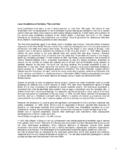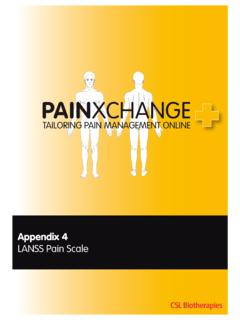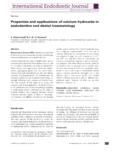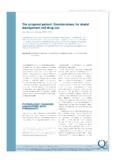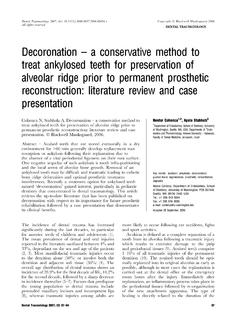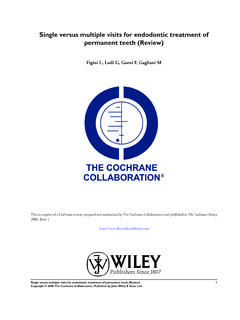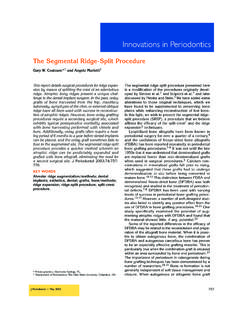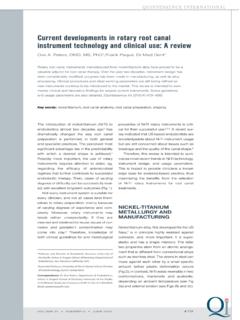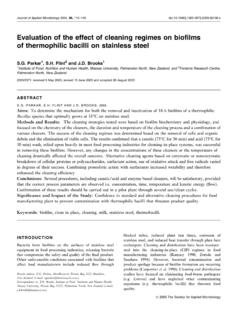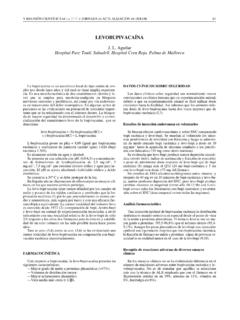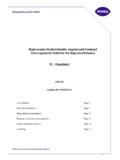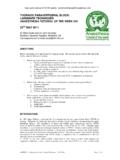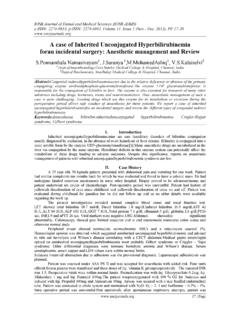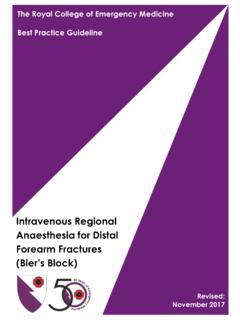Transcription of COMPARISON OF ARTICAINE AND LIDOCAINE …
1 1 COMPARISON OF ARTICAINE AND LIDOCAINE USED AS DENTAL local ANESTHETICS by rjan Johansen Project Thesis 10. semester ( H-99) May 2004 Section of Dental Pharmacology and Pharmacotherapy, Institute of Clinical Dentistry, Faculty of Dentistry University of Oslo 2 Page Contents 2 Preface 3 Introduction 3 The basic properties of ARTICAINE and LIDOCAINE 4 Factors affecting local anesthetic action 5 Pharmacokinetics 6 Uptake 6 Distribution 7 Metabolism (Biotransformation) 7 Excretion 8 Pharmacodynamics 8 Clinical COMPARISON of ARTICAINE versus LIDOCAINE 9 Safety 9 Efficacy 10 Use in pediatric dentistry 13 Use in geriatric patients 15 Complications 16 Why is ARTICAINE delivered as a 4 % solution?
2 20 Discussion 20 References 22 3 Preface This paper is submitted as partial fulfillment of the requirements for the degree Candidatus/Candidata Odontologiae (DDS) by the Faculty of Dentistry, University of Oslo, Norway. Introduction local anesthesia is an important part of the daily routines for a dentist. In Norway alone a significant number of carpules (cartridges) of local anesthesia is injected every year. The first substance that was used for this purpose was cocaine, as far back as in 1884. In 1903, Braun suggested using adrenaline as a chemical tourniquet to prolong the duration of local anesthetics. In 1904 Einhorn synthesized procaine, an ether anesthesia. In the 1940 s a new group of local anesthetic compounds, the amides, were introduced. The initial amide local anesthetic, LIDOCAINE , was synthesized by the Swede chemist Nils L fgren in 1943.
3 LIDOCAINE revolutionized pain control in dentistry worldwide, as it was both more potent and less allergenic than procaine. In the succeeding years, other amide local anaesthetics (prilocaine in 1953 by L fgren and Tegner, bupivacaine and mepivacaine in 1957 by A. F. Ekenstam, etidocaine in 1971 by Takman) were introduced. These researchers gave the dental practitioner a local anesthetic armamentarium which provided pulpal anesthesia for periods lasting from 20 minutes (mepivacaine) to as long as three hours (bupivacaine and etidocaine with adrenaline). In addition, these popular drugs proved to be more rapid-acting than the older ester-type drugs and, at least from the perspective of allergenicity, safer. In 1969, Rusching et al. prepared a new drug, ARTICAINE . It differed from the previous amide local anesthetics in that it was derived from thiophene, and because of that contained a thiophene ring in its molecule in stead of the usual benzene ring.
4 It was first named carticaine, but its generic name was changed to ARTICAINE in 1984. It was introduced onto the German market in 1969. (Malamed 1997) For time being, ARTICAINE combined with adrenaline 1:100 000 and 1:200 000 has a market share in Norway of approximately 50 % per January 2004 (personal communication T. Stjernesund), while LIDOCAINE , prilocaine and mepivacaine constitute the rest. In other countries like Canada, Italy, France and the Netherlands, ARTICAINE is the number one choice, and in Germany more than 90 percent of the local anesthesia used by dentists is ARTICAINE (Isen 2000). 4 The purpose of this article is to present a brief COMPARISON of ARTICAINE and LIDOCAINE as used in dentistry. The basic properties of ARTICAINE and LIDOCAINE The chemistry and pharmacology of a local anesthetic can give valuable information about which clinical effects you can expect when you use them.
5 The most important ones for both ARTICAINE and LIDOCAINE are listed in table 1. Table 1, Physical/chemical properties Substance ARTICAINE LIDOCAINE Chemical formula 3-N-Propylamino-proprionyl-amino-2-carbo methoxy-4-methylthiophene hydrochloride 2- Diethylamino 2 , 6-acet-oxylidide hydrochloride Structure formula NHPr-nMeMeOMeNHCCHOCSO NEt2 MeMeNHCCH2O Classification Amide Amide Molecular weight ( Jastak & al 1995) ( Jastak & al 1995) Partition coefficient Log P (o/w) (Hoechts Marion Roussel 1999) (SRC PhysProp Database 2004) Vd (ss) +/- L/kg ( Oertel & ) 91 ( Jastak & al. 1995) pKa (Malamed 1997) (Malamed 1997) Lipid solubility ( malamed & al.)
6 2000) ( Malamed & al. 2000) Plasma protein binding 76 % ( pH ) 54 % ( pH ) ( Oertel & Richter 1998) 74 % ( pH ) 61 % ( pH ) ( Oertel & Richter 1998) 5 Table 2, Content in one carpule pr. ml. Septocaine ml Septocaine forte ml Xylocaine/adrenaline ml 40mg, adrenaline 5 g, natr. metabisulfis (E223) mg, natr. edet. mg, natr. chlorid mg, natr. hydroxid., aqua ad inject. ad 1 ml. 40 mg, adrenalin. 10 g, natr. metabisulfis (E223) mg, natr. edet mg, natr. chlorid mg, natr. hydroxid., aqua ad inject. ad 1 ml. 20 mg, adrenalin. g, natr. chlorid. , natr. metabisulfis (E223) mg, aqua ad inject. ad 1 ml. (Felleskatalogen 2003) Factors affecting local anesthetic action The dissociation constant (pKa) affects the onset of action. Lower pKa, means that more uncharged base molecules are present to diffuse through the nerve sheath; thus onset time is decreased.
7 Lipid solubility affects the anesthetic potency. Increased lipid solubility permits the anesthetic to penetrate the nerve membrane, which itself is 90 % lipid (Malamed 1997), more easily. ARTICAINE differs from all other amide local anesthetics, in that it is derived from thiophene. As a result, the ARTICAINE molecule does not contain a benzene ring like the others but instead contains a thiophene ring. This renders the molecule more lipid soluble and therefore better able to cross lipid barriers, for example the nerve membrane (Isen 2000). Protein binding affects the duration. Increased protein binding allows anesthetic cations to be more firmly attached to proteins located at receptor sites. Thus the duration of action is increased. Vasodilator activity affects both the anesthetic potency and the duration. Greater vasodilator activity leads to increased blood flow to a region, which leads to a rapid removal of anesthetic molecules from the injection site.
8 This will decrease both the anesthetic potency, and duration. Both ARTICAINE and LIDOCAINE as plain solutions without a vasoconstrictor added would be ineffective and more toxic because of their vasodilator activity. In order to improve both the duration and safety, adrenaline is added which act as a vasoconstrictor. In Norway 6there are different preparations available. Those that are available for time being are listed in table 3. Table 3, Preparations Product Content Adrenaline Manufacturer Xylocain-adrenaline, ml. LIDOCAINE 20 mg/ml + adrenaline g/ml 1:80 000 Dentsply Septocaine forte, ml. ARTICAINE 40 mg/ml + adrenaline 10 g/ml 1:100 000 Septodont Septocaine, ml ARTICAINE 40 mg/ml + adrenaline 5 g/ml 1:200 000 Septodont (Felleskatalogen 2003) Pharmacokinetics local anesthetics block the sensation of pain by interfering with the propagation of peripheral nerve impulses.
9 Both the generation and the conduction of action potentials are inhibited. Electrophysiological data indicate that local anesthetics do not significantly alter the normal resting potential of the nerve membrane; instead, they impair certain dynamic responses to nerve stimulation (Strichartz & Ritchie 1987). local anesthetics interfere with nerve conduction by blocking the influence of stimulation on Na+ permeability. A developing local anesthetic block is characterized by a progressive reduction in the rate and extent of depolarization and a slowing of conduction. Since the onset and rate of repolarization are not greatly affected by local anesthetics, the safety factor for transmission decreases. When depolarization is retarded such that repolarization processes develop before the threshold potential can be reached, nerve conduction fails (Jastak & al.)
10 1995). Uptake When injected into soft tissues, local anesthetics exert a pharmacological action on the blood vessels in the area. All local anesthetics possess a degree of vasoactivity, although the degree may vary. Most local anesthetics produce dilation of the vascular bed into which they are deposited. To a slight degree these effects may be concentration dependent. A significant 7effect of vasodilation is an increase in the rate of absorption of the local anesthetic into the blood, thus decreasing the duration of pain control while increasing the anesthetic blood level and the potential for overdose. These effects are also related to the vascularity of the injection site (Malamed 1997). To compensate for this effect, most local anesthetics are manufactured as solutions containing a vasoconstrictor, for example adrenaline or felypressin.
